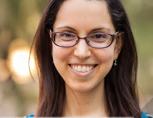 Nicole Yunger Halpern is a theoretical physicist at Caltech’s Institute for Quantum Information and Matter (IQIM). She blends quantum information theory with thermodynamics and applies the combination across science, including to condensed matter; black-hole physics; and atomic, molecular, and optical physics. She writes for Quantum Frontiers, the IQIM blog, every month.
Nicole Yunger Halpern is a theoretical physicist at Caltech’s Institute for Quantum Information and Matter (IQIM). She blends quantum information theory with thermodynamics and applies the combination across science, including to condensed matter; black-hole physics; and atomic, molecular, and optical physics. She writes for Quantum Frontiers, the IQIM blog, every month.
What makes extraordinary science extraordinary?
Political junkies watch C-SPAN. Sports fans watch ESPN. Art collectors watch Christie’s. I watch scientists respond to ideas.
John Preskill—Caltech professor, quantum-information theorist, and my PhD advisor—serves as the Chief Justice John Roberts of my C-SPAN. Ideas fly during group meetings, at lunch outside a campus cafeteria, and in John’s office. Many ideas encounter a laconicism compared with which Ernest Hemingway babbles. “Hmm,” I hear. “Ok.” “Wait… What?”
The occasional idea provokes an “mhm.” The final syllable has a higher pitch than the first. Usually, the inflection change conveys agreement and interest. Receiving such an “mhm” brightens my afternoon like a Big Dipper sighting during a 9 PM trudge home.
Hearing “That’s cool,” “Nice,” or “I’m excited,” I cartwheel internally.
What distinguishes “ok” ideas from “mhm” ideas? Peeling the Preskillite trappings off this question reveals its core: What distinguishes good science from extraordinary science?
I’ve been grateful for opportunities to interview senior scientists, over the past few months, from coast to coast. The opinions I collected varied. Several interviewees latched onto the question as though they pondered it daily. A couple of interviewees balked (I don’t know; that’s tricky…) but summoned up a sermon. All the responses fired me up: The more wisps of mist withdrew from the nature of extraordinary science, the more I burned to contribute.
I’ll distill, interpret, and embellish upon the opinions I received. Italics flag lines that I assembled to capture ideas that I heard, as well as imperfect memories of others’ words. Quotation marks surround lines that others constructed. Feel welcome to chime in, in the “comments” section.
One word surfaced in all, or nearly all, my conversations: “impact.” Extraordinary science changes how researchers across the world think. Extraordinary science reaches beyond one subdiscipline.
This reach reminded me of answers to a question I’d asked senior scientists when in college: “What do you mean by ‘beautiful’?” Replies had varied, but a synopsis had crystallized: “Beautiful science enables us to explain a lot with a little.” Schrodinger’s equation, which describes how quantum systems evolve, fits on one line. But the equation describes electrons bound to atoms, particles trapped in boxes, nuclei in magnetic fields, and more. Beautiful science, which overlaps with extraordinary science, captures much of nature in a small net.
Inventing a field constitutes extraordinary science. Examples include the fusion of quantum information with high-energy physics. Entanglement, quantum computation, and error correction are illuminating black holes, wormholes, and space-time.
Extraordinary science surprises us, revealing faces that we never expected nature to wear. Many extraordinary experiments generate data inexplicable with existing theories. Some extraordinary theory accounts for puzzling data; some extraordinary theory provokes experiments. I graduated from the Perimeter Scholars International Masters program, at the Perimeter Institute for Theoretical Physics, almost five years ago. Canadian physicist Art McDonald presented my class’s commencement address. An interest in theory, he said, brought you to this institute. Plunge into theory, if you like. Theorem away. But keep a bead on experiments. Talk with experimentalists; work to understand them. McDonald won a Nobel Prize, two years later, for directing the Sudbury Neutrino Observatory (SNO). (SNOLab, with the Homestake experiment, revealed properties of subatomic particles called “neutrinos.” A neutrino’s species can change, and neutrinos have tiny masses. Neutrinos might reveal why the universe contains more matter than antimatter.)
Not all extraordinary theory clings to experiment like bubblegum to hair. Elliott Lieb and Mary Beth Ruskai proved that quantum entropies obey an inequality called “strong subadditivity” (SSA). Entropies quantify uncertainty about which outcomes measurements will yield. Experimentalists could test SSA’s governance of atoms, ions, and materials. But no physical platform captures SSA’s essence.
Abstract mathematics underlies Lieb and Ruskai’s theorem: convexity and concavity (properties of functions), the Golden-Thompson inequality (a theorem about exponentials of matrices), etc. Some extraordinary theory dovetails with experiment; some wings away.
One interviewee sees extraordinary science in foundational science. At our understanding’s roots lie ideas that fertilize diverse sprouts. Other extraordinary ideas provide tools for calculating, observing, or measuring. Richard Feynman sped up particle-physics computations, for instance, by drawing diagrams. Those diagrams depict high-energy physics as the creation, separation, recombination, and annihilation of particles. Feynman drove not only a technical, but also a conceptual, advance. Some extraordinary ideas transform our views of the world.
Difficulty preoccupied two experimentalists. An experiment isn’t worth undertaking, one said, if it isn’t difficult. A colleague, said another, “does the impossible and makes it look easy.”
Simplicity preoccupied two theorists. I wrung my hands, during year one of my PhD, in an email to John. The results I’d derived—now that I’d found them— looked as though I should have noticed them months earlier. What if the results lacked gristle? “Don’t worry about too simple,” John wrote back. “I like simple.”
Another theorist agreed: Simplification promotes clarity. Not all simple ideas “go the distance.” But ideas run farther when stripped down than when weighed down by complications.
Extraordinary scientists have a sense of taste. Not every idea merits exploration. Identifying the ideas that do requires taste, or style, or distinction. What distinguishes extraordinary science? More of the theater critic and Julia Child than I expected five years ago.
With gratitude to the thinkers who let me pick their brains.



Brilliant!
Wonderful guest post. Thank you Dr Halpern!
I liked that question “what do you mean by beautiful?” To me, its like music, what makes beautiful music? Or what makes a beautiful woman? It’s rhythm, harmony, symmetry, expressiveness, simplicity, richness. The last two seem to be in opposition, but really, its richness in the simplest possible way. You know, you study a theory and its a mess of equations, but you keep at it and there’s that moment when you go “oh, right” and you see that the mess of equations are just a mess of ways of looking at the same beautiful thing.
“What do you mean by beautiful” Love this question and I have been asking this all my life.
Thank you for the post. Brilliant
John
I am not a physicist. Heck, I’m not a scientist. But, I so appreciate Dr Halpern’s ability to take simple statements, make them complicated and then bring them back down to us little people. I want to understand and she makes me think I can. Bravo Dr. Halpern. Thank you.
Sounds like the supreme court’s relationship to pornography.
While in grad school, intrigued by the role of beauty in science and mathematics, I came upon an expanded version of S. Chandrashekhar’s Reith Lecture: Truth and Beauty. Aesthetics and Motivations in Science. Chicago: The University of Chicago Press. ISBN 0-226-10087-1. He describes the work of individual scientists and how a search for “beauty” led them to truth. I found it inspiring at that time.
To elaborate on the earlier, banal comparison, I think what’s interesting is not so much beauty, but taste. There is obviously no intrinsic beauty in math or science (or anything at all; if there’s a more observer dependent quality than “beauty” I’d like to see it), and so being able to discern what is “more beautiful” about certain things is a matter of taste, which requires a well cultivated connoisseurship. How does a scientist develop this? I think that’s a very interesting question. There’s a lot less explicit training about this. Occasionally it will show up in the introductions to textbooks, “Chapter 5 is the most important, a one semester course should skip 4 and aim for this one,” that sort of thing.